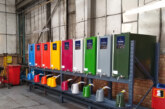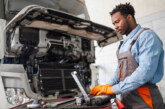What are the benefits of self-steering axles?

BPW says its LL self-steering axles are compliant with new longer semi-trailer regulations and paving the way for safer and more efficient transportation.
When the Department of Transport (DfT) announced new legislation changes in May 2023, that permitted longer semi-trailer (LSTs) combinations – with a maximum length of 18.55m – the move was intended to support the government’s drive for further economic growth, emission reduction and strengthening supply chains.
The introduction of LSTs was designed to facilitate the transportation of larger quantities of goods, resulting in a reduction of 8% fewer journeys than current trailers. This was expected to generate £1.4 billion in economic benefits and take one standard-size trailer off the road for every 12 trips, further contributing to enhanced logistics and environmental sustainability. Vehicles which use LSTs are subject to the same 44-tonne gross combination weight limit as those using standard trailers. These new vehicles are also expected to cause less wear on the road than conventional trailers due to the type of steering axles used.

Greater efficiency
The move followed an 11-year trial, confirming the well-established benefits of increasing vehicle capacity: reduced costs, estimations of saving 70,000 tonnes of CO2 from being released into the atmosphere and a reduced number of trailers on our roads. After an active involvement in supporting the trials, BPW welcomed the approval which demonstrates the improvement in transport efficiency that can be achieved with the right technology.
Benefits
With its unique capabilities, the BPW LL self-steering axle not only enables compliance with the new LST regulations but also delivers substantial environmental, and economic advantages providing an advanced and intuitive system that offers enormous benefit to the industry. The simple passive steering components enable automatic, load-dependent control.
The performance characteristics of the LL self-steer axle have been well documented: these include enhanced manoeuvrability, lower fuel consumption, lower tyre costs, and reduced stress on the chassis. The benefits are simply achieved: the self-steering axle operates without the need for power-assisted steering control stabilisers. It is automatically controlled according to the load being carried, and because the design itself is so simple, the number of individual components required is low. This saves weight and reduces installation and maintenance costs.

Manoeuvrability
Conventional active and control steering axle designs require steering stabilisers powered from an external source – this is not the case with the BPW self-steering axle. The axle beam and axle stub are connected to corrugated thrust bearings mounted under the kingpin assemblies. When driving straight (zero position), the corrugations in the thrust washers keep the wheels on track, while the vehicle’s weight is used to keep the washers in contact providing load-sensitive damping and ensuring optimal performance.
LL stands for ‘load-dependant steering stabilisation’ and it describes the unique functional principle of the BPW self-steering axle. The axle has been designed with a self-locking facility when reversing. Unlike other systems, as soon as the trailer begins to move backwards, the steering mechanism is locked in the straight-ahead position. Forces acting on the tyres when cornering are distributed more evenly. As a result, it has been shown that the life of the tyres on the front axle increases by up to 50%, while those of the rear axle can increase by as much as 70%.
The LL self-steering axle shows off its strengths particularly thanks to its greater manoeuvrability on corners and when making turns, leading to more straightforward vehicle handling, less tyre wear and lower fuel consumption – over a distance of 100,000 km that adds up to as much as 1,000 l of fuel saving and more than four tyres per vehicle – just work that out for your entire fleet!
Compliance
According to the DfT, operators are legally required to ensure the implementation of appropriate route plans and risk assessments that account for the unique specifications of LSTs.
Alongside these newly imposed legal requirements, operators are also be expected to conduct extra safety checks including driver training and scheduling, record keeping, training for transport managers, and proper loading practices of LSTs.

With the ever-increasing demands placed on fleet managers, it is essential to have a solution that optimises efficiency and prioritises safety and sustainability. BPW LL self-steering axles provide a reliable and efficient solution, ensuring compliance with new laws governing longer semi-trailers. By incorporating these axles into fleets, managers can optimise their operations and maximise load capacity while remaining fully compliant.
Better by degrees
The BPW LL self-steering axle is available with steering angles of between 12 and 27°, with the latter being suited for longer semitrailers. Based on the proven beneficial principles of their existing self-steer, this additional angle of steer enables allocated licence holders of 15.65m trailers to consider a self-steer axle, with no sacrifice of payload capability, against a more costly and heavier active or command steer system on their trailers.









